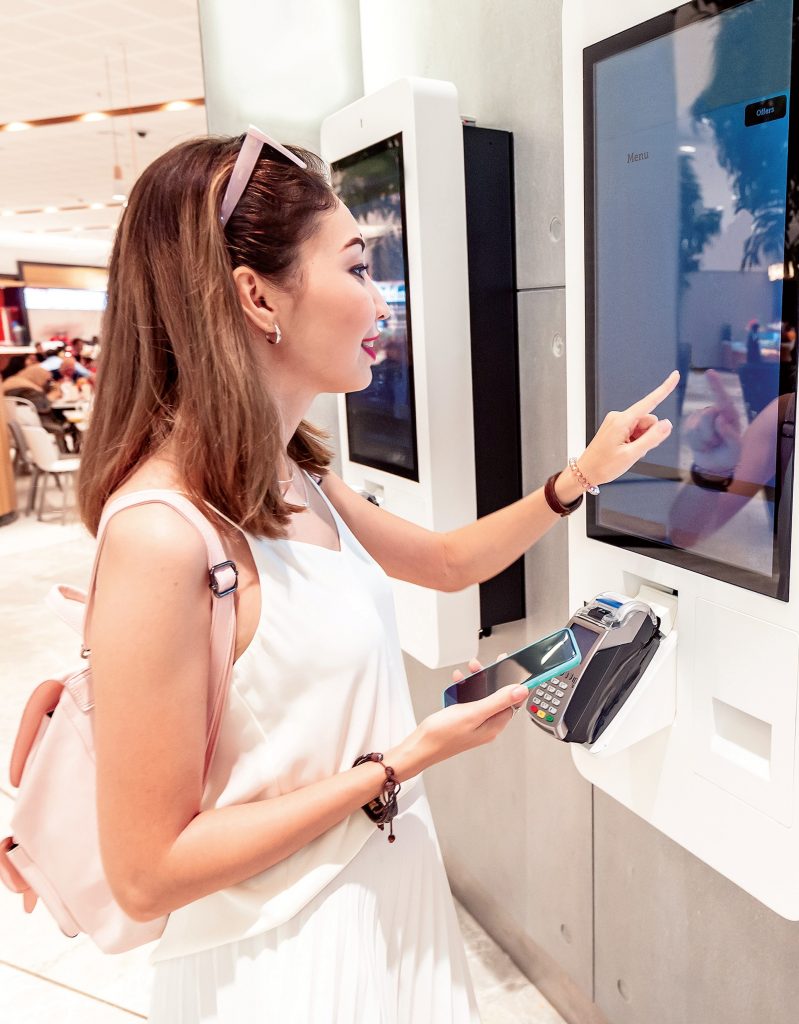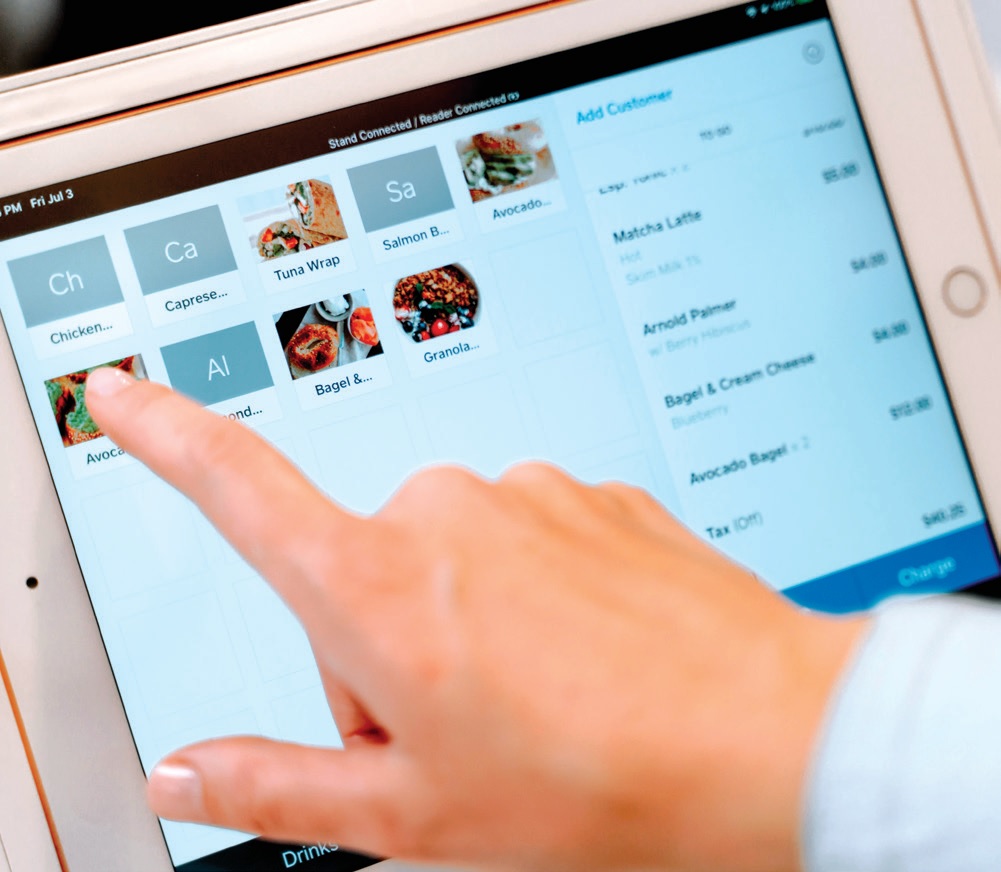Technology on the Menu
Posted by estiator at 7 May, at 04 : 28 AM Print

Restaurants go digital to survive the pandemic.
By Michael Kaminer
A customer gives her order to a server. The server scribbles the order on a pad. The server rips out the page and sticks it in a queue near the kitchen. The cook prepares what he sees on the page.
If this episode makes you nostalgic for the way restaurants used to work, it may be time to let go.
Even before Covid-19, technology was transforming restaurants. Now, more than a year into the pandemic, tech has reinvented the industry. In some cases—like app-driven “ghost kitchens”—restaurants aren’t even restaurants anymore.
The change is driven by both the needs of operators and the desires of customers. “Until now, the restaurant industry was not an early adapter of technology. The pandemic has accelerated change,” says Barbara Castiglia, executive editor of New Jersey–based Modern Restaurant Management, which covers tech extensively. “A couple of years ago, I’d be at trade shows where companies would demonstrate things like pay-at-table. Restaurant owners would say, ‘That’s nice, but I have other things to do.’ Now, those ‘nice-to-haves’ are must-haves.”
Much of the urgency revolves around keeping customer engagement contactless, Castiglia says. That might cover everything from the menu to ordering to payment. QR codes, for example—the bar codes scanned by smartphones to open web pages—had fallen out of favor until restaurants found creative uses for them.
“Everyone wants to keep guests safe, comfortable, and coming back,” she says. “It’s a way for restaurants to stay alive for meeting the guest’s needs, wherever they are. The guest wants a menu on a smartphone? Sure. They want to pay at the table, or through their phone? We’ll meet them there. It’s become important to staying in business.”
Companies like Clover (point-of-sale systems), Toast (point-of-sale, ordering, hardware), Sysco’s CAKE (operations), BentoBox (mobile tech), and Zenreach (data, marketing) have seen “thousand-percentage increases” in their business since the pandemic’s onset, Castiglia says.

Barbara Castiglia, Modern Restaurant Management 
Dan Jacobs, Restaurant Accounting Solutions Inc. 
Megan Wintersteen, Zenreach
But Castiglia also notes that the engagement with technology starts before a customer is even a customer. “Many people’s introductions to a restaurant now happen online,” she says. “The search term ‘restaurants near me’ is huge. Even if you’re a mom-and-pop, you want to have a presence on Google—you can ‘own’ it on Google, which is free. It could be something as simple as your hours, your Covid procedures, or your pickup/delivery guidelines.”
For restaurateurs who are still trying to adapt, the most critical first step is a pointof-sale (POS) system, Castiglia advises. According to business site The Balance, POS is “a computerized system that allows business owners to track sales, cash flow, food inventory and can help simplify your bookkeeping enormously…a POS system track every penny of your sales. It simplifies communications between the kitchen and the wait staff. It can help prepare payroll.”
POS “is the training wheels, the foundation,” Castiglia says. “It’s the heartbeat of so many things in operations. A lot of operators say, ‘We’ve been doing it our own way for years, and it works.’ But this could ease their burdens.”
For Dan Jacobs, chief operating officer of Denver-based Restaurant Accounting Solutions Inc., branding and web optimization is just as critical. RASI consults on service, marketing, and operations to independents, franchises, and larger concepts. “Is your website optimized for great search placement when someone is searching for your type of cuisine? Do you leverage H1 tags [HTML “header” tags] on specific menu items or geolocation insights to drive new guests into learning more about your brand?”
But as Jacobs notes, technology requires an investment to generate returns. “The biggest mistake we see among clients coming to RASI is that they’ve taken a DIY approach to technology, which can mean cutting corners along the way.” Instead, he recommends a multi-step process to find the right partner.
First, “Partner with a company that you believe is committed to your success,” he says. Do they have a dedicated client success team, for example? “Ask tough questions around their service level agreements—like ‘What should I expect if this tech breaks on a Friday night?’ Verify their responses with other customer referrals. Second, he says, “Seek out companies that believe in integration,” including connectivity to key systems like POS, accounting, payroll, and inventory.
Third, Jacobs advises, “Incorporate your management team or other key stakeholders in the process as much as possible. Fourth, “Set clear expectations for both you and your new solution partner.” And last, but not least, “Look at things with a new, fresh perspective and understand there is a natural learning curve. New solutions often include changes that can be hard to accept.”
That willingness to adapt is a key determinant of success with tech implementation, agrees Megan Wintersteen, vice president of marketing for San Francisco-based Zenreach. The company helps brands like Peet’s Coffee, Buffalo Wild Wings, and Dinex Restaurant Group customize digital marketing by gathering data over from walk-in customers who sign into branded wifi networks.

“What we’ve seen over the past year is that the need for adaptation and evolution in f-and-b tech was dire,” she tells Estiator. “That means everything from complete changes of business models, like going takeout-only, to going contactless, which was the biggest driver.”
While marketing “was the first thing to get cut from restaurant budgets,” Zenreach’s business has picked up as pandemic restrictions loosen and foot traffic has increases. The company creates its own QR codes to help clients tout free wifi; “it’s a great way to increase contact collection,” Wintersteen says. “Then we can serve you up customized menus, promotions, and incentives.” Zenreach also integrates with POS systems, “so you can tell that out of the 100 customers who checked out yesterday, 50 of them were driven by your marketing efforts, and those 50 had higher order values than the other 50.”
Ultimately, restaurateurs won’t be able to consider technology as an afterthought or an adjunct to their business; to compete, operators will have to make tech an integral part of their restaurant’s DNA, in the same way that creativity and hospitality have traditionally been. “It’ll become even more of a factor moving forward, and restaurateurs have to understand it more,” says Castiglia of Modern Restaurant Management.
In fact, surveys reveal that both consumers and operators plan to hang onto tech habits adopted during the pandemic. A February poll by location-app company Bluedot concluded that 8 in 10 consumers plan to continue their current dining habits even after the pandemic subsides, including a reliance on apps and off-premise dining. And an early 2021 survey by tech company Square noted that nearly half of restaurant owners or managers plan to continue offering digital menu access using URL or QR codes for the foreseeable future.
“There was always a fear that technology took away from hospitality. But the best technology actually enhances it,” she says. “It helps you get things done so you can have face time with guests and focus on them.”
At the same time, “you don’t want to rely on it 100%. It’s a creative business. Understand it, implement it, but also be cautious—a lot of products may not work for your business. Know your operation to know which technology tools will help you succeed.”
WHICH TECH WORKS FOR YOU?
Bento Box doesn’t serve Japanese food. Clover isn’t leafy. And CAKE isn’t baked. All of them are restaurant technology companies—tempting names on the long menu of service brands from which restaurateurs can choose. Which makes sense for you? As a first step, Estiator has assembled a quick guide to some of the category leaders. You may already use one or more of them; you might end up partnering with another as the year goes on and the pandemic throws more curveballs. Either way, there’s a good chance they’ll become a bigger part of your business this year.
■ Square (squareup.com):
Co-founded by Jack Dorsey, who also launched Twitter, Square started as a mobile payment platform. It now offers cloud-based POS systems, kitchen display systems, and online ordering.
■ Bluedot (bluedot.io):
Bluedot offers “geofencing” software for apps; simply put, that means operators can use location to sequence mobile orders and prioritize kitchen tickets.
■ Scanour (scanour.menu):
Scanour helps restaurants convert conventional menus to contactless ordering systems and mobile platforms. Scanour’s software doesn’t yet integrate with POS systems, but the company promises an upgrade soon.
■ BentoBox (getbento.com):
BentoBox “focuses on and celebrates a restaurant’s digital property,” founder and CEO Krystle Mobayeni told Zagat.com. That means optimizing web pages, enhancing mobile sites, enabling digital commerce, and equipping restaurants with QR codes and other tools.
■ Clover (clover.com):
Clover’s POS systems enable online ordering, contactless payments, and real-time reporting. Clover recently added QR-code “scan-to-order” features to its suite of services.
■ CAKE (trycake.com):
While it offers POS tools similar to other providers’, CAKE has food-service DNA; it’ s part of giant restaurant supplier Sysco. Services span “mobile marketing and waitlist management to point of sale and payment processing,” according to its site.
■ Zenreach (zenreach.com):
Zenreach calls its services “walkthrough marketing.” Customers sign into a branded wifi portal, which allows Zenreach clients to targetmarket as well as track traffic, buying habits, and order size.
■ Heartland (heartlandpaymentsystems.com):
Heartland provides point-of-sale solutions to restaurant and retail businesses; it also supplies integrated payment processing and payroll and customer engagement solutions. Cloud-based POS systems are a focus.
■ Toast (pos.toasttab.com):
Point of sale, contactless ordering, handhelds, online ordering and delivery, marketing, payroll management, even gift and loyalty programs… Toast was built specifically for restaurants, and operates on a cloud-based system.















